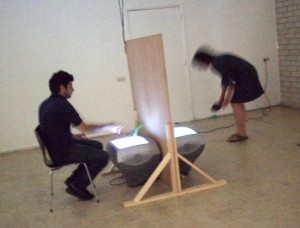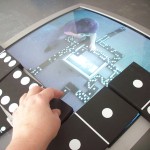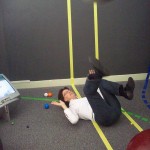A number of TV-games that I tried out before hitting on the Double Solo game.…
Me, you and the identity game

Staging the Self – notes from my game/essay:
“The purpose of play is to hallucinate ego mastery.” (1).
“When words bec0me the only basis for establishing meaningful relationships and other such egalitarian fictions, then the voices of authority are no longer given value or trust … This has been the holy project of secular humanism: the ritualization of the construction of one’s self.” (2).
”The notion of identity has been supplanted by that of actions performed, by the concept of staging the Self, which implies the perpetual mobility of the subject.”(3)
Of course, identity has always been (in part) played. The roles that suit us remain, the roles that feel uncomfortable get discarded. Using the eyes of others as reflectors we construct our self, or selves. This is a process that is with us from our earliest days, a set of conscious/unconscious decisions that shape who we are and what we want to be.
The Double Solo experimental game that I have set up can be read as being about conscious/unconscious control and choice. The game’s visual, auditive and kinesthetic feedback loops present players with images of themselves that are contrary to what they expect. Its feedback loops are carefully constructed to achieve disruption.
The game defeats players desire to be (seen as) skillfull, in control, masters of the game. Au contraire, the game shows how not in-control they are, how the game involves them in patterns out of conscious control. Even if players are reluctant to give in to the surprises the game has in store for them, while playing they are forced to let go. Which brings them, in a way, closer to the mind’s real functioning – more often than adults like to give credit for the mind will play its own recordings: daydreams, hallucinations, fantasies. Very little of which is actively under control. “Dreams exist to amuse the brain into continued labile alertness. Play exists to amuse the body to the same consummation of wholeness in a virtual world.”(4)
My games – online, offline, in public space and private spaces – play the identity game. The personality(ies) embedded in players’ consciousness are cracked open by the elements of surprise and non-control.
Of course, a number of people choose to not play my games at all. An atelier space generated a larger number of players than an art gallery; a museum crowd proved more responsive than people out shopping. It seems that adults are disinclined to play when watched by other people, or in situations where playful behaviour would be seen as deviant.
People that do play work to supply the game’s missing elements. Some become narrators, inventing stories to make the game exiting. Some add to the game by drawing new elements or altering existing ones, or making new connections. Some set themselves (im)possible goals. Others play the game by self-invented rules – often imposing those rules on others and enjoying doing so.
Finding (visual) ways and means to overcome a non-play attitude has become a major theme in my practice. For other than Michael Portnoy (who is master of his games) and Ricardo Basbaum (who participates in his) I choose to disappear from the scene once the game space is set. This makes the formal elements of my propositions (larger-than-life chalks, balls, table tennis bats) very important. The environment I prepare must be recognisable as a play space at first glance. And be inviting enough to get a game going. In my experiments, this much has become clear: To bring my work forward, I may be forced to reconsider my own position.
(1) Erik Erkison, Childhood and Society, 1956
(2) Roger Abrahams, the Anthropology of experience, 1986
(3) Nicholas Bourriaud, The Radicant, 2009
(4) Brian Sutton-Smith, The Ambiguity of Play, page 62.
| « Essay cum game | <-- previous post | next post --> | Before and after at AWK » |
|---|







